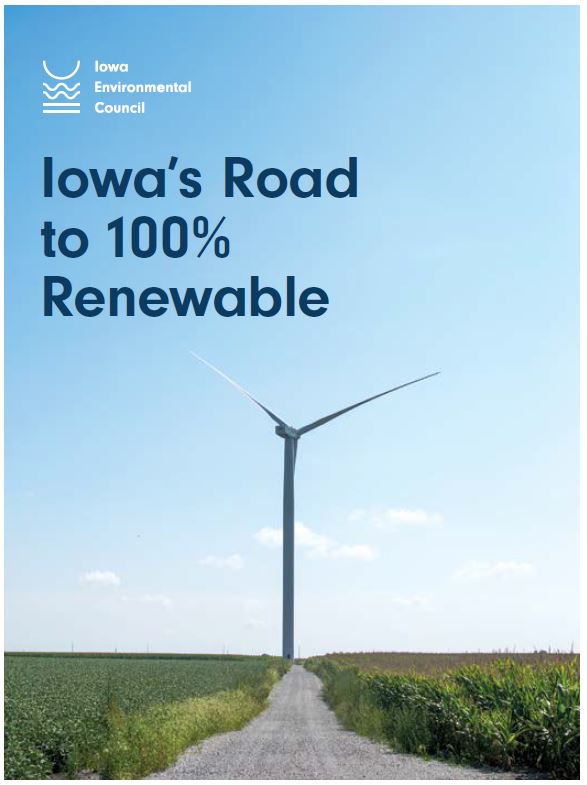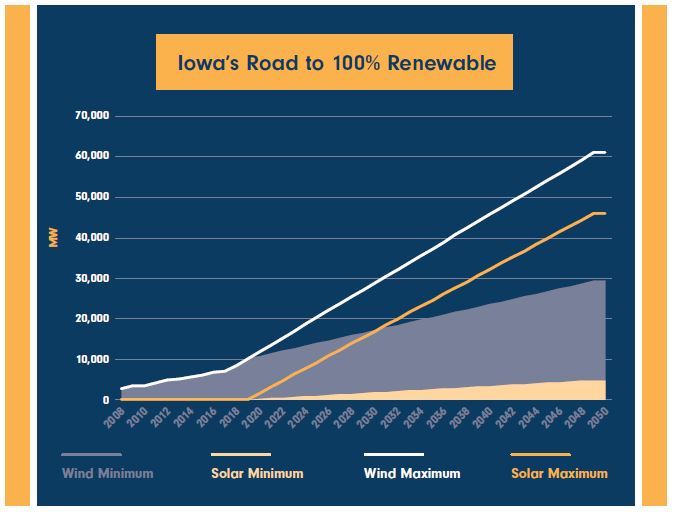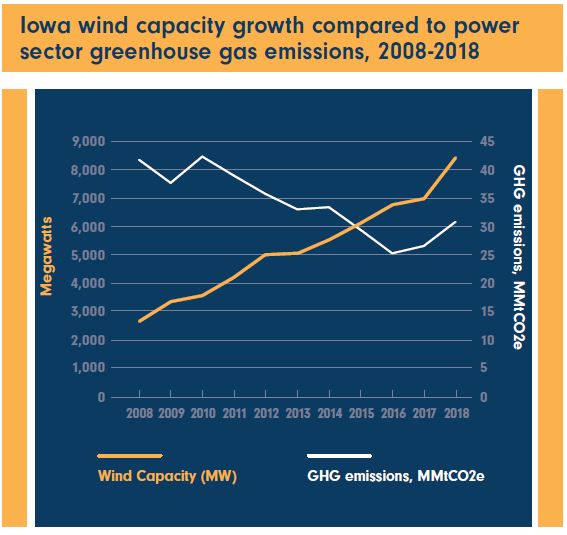IEC Releases Iowa's Road to 100% Renewable
posted
on Tuesday, April 21, 2020
in
Energy News
Large expansion of wind, solar energy, and new technology investments can move the state to run on clean energy
 DES MOINES – The Iowa Environmental Council, the state’s largest non-profit environmental coalition, today released the publication of Iowa’s Road to 100% Renewable - an analysis of the renewable energy growth needed to reach 100% renewable electricity in Iowa by 2050.
DES MOINES – The Iowa Environmental Council, the state’s largest non-profit environmental coalition, today released the publication of Iowa’s Road to 100% Renewable - an analysis of the renewable energy growth needed to reach 100% renewable electricity in Iowa by 2050.
“Iowa has long been a leader in renewable energy as a state with some of the best wind resources in the country,” said Steve Guyer, Energy and Climate Policy Specialist with the Iowa Environmental Council. “There is an emerging trend of states setting goals to reach 100% renewable electricity. We wanted to see what it would take for Iowa to reach that goal, also recognizing that Iowa’s renewable energy can and should be exported to help the country as a whole strive for a zero-carbon energy system.”
Iowa’s Road to 100% Renewable examines the results of twelve recent studies focused on reaching high penetrations of renewable energy in the U.S., with several providing breakdowns of what that would mean for renewable energy development in each state. The studies showed that Iowa would need between 30,000 and 61,000 MW of wind and 5,000 to 46,000 MW of solar to provide 100% renewable electricity and help the U.S. phase down use of fossil fuels.
“With more than 10,000 Megawatts of wind now in Iowa, the state has reached an important threshold by generating more power from wind than from coal in 2019. The state currently has 110 MW of solar, with at least 850 MW more under construction,” said Kerri Johannsen, the Council’s Energy Program Director.
“Ten years ago, having 10,000 MW of wind seemed like an almost impossible benchmark and 1,000 MW of solar unlikely. Yet, by combining favorable government policies and private sector investments, we have arrived at a place reflective of consumer demand for clean energy in Iowa. It will take similar concerted efforts to reach the next level in the deployment of renewables needed to reach 100% renewable electricity, but we are confident we can get there.”

The studies examined by the Council took a variety of approaches, with some focusing just on renewables and others incorporating technologies like nuclear and carbon capture and storage. The studies also touched on the need to use energy more efficiently to reduce overall demand and how battery storage can play a role.
“Greenhouse gas emission from Iowa’s electricity sector fell between 2008 and 2016 as more wind came online, dropping electricity from the number one source of emissions to number three behind the building and agriculture sectors,” noted Guyer.
“Unfortunately, electric sector emissions went up in 2017 and 2018. We can’t rest on the progress we have made. Instead we must continue to move forward with more renewables.”

One major influence over the level of renewables needed is whether there is widespread electrification of sectors currently fueled by fossil fuels such as transportation, building heat, and manufacturing processes. Electrifying end-uses and utilizing electricity produced through renewable sources can quickly reduce greenhouse gas emissions. However, with more electricity demand comes the need for more renewable electricity. The high-end estimates of needed renewables are for those scenarios with high levels of electrification.
“There are different ways to get to 100% clean energy,” said Guyer. “But no matter what the pathway, all results show Iowa needs to double down on its historical support of renewables now, making sure our short-term decisions are consistent with this long-term goal.”
“Wind and solar together provide 11,000 jobs in Iowa along with millions in land lease payments and local property taxes. Renewables are also now cheaper than fossil fuels in most cases. The economic case is there for continuing down this path to 100% renewable energy,” said Johannsen. “We hope this work can provide a road map to envision Iowa as a major national supplier of clean energy in addition to showing leadership within our own borders.”
Read Iowa’s Road to 100% Renewable at IEC’s website.
For more information on renewable energy in Iowa, visit IEC's Renewable Energy Works for Iowa webpage.
- carbon pollution
- clean energy
- climate change
- energy efficiency
- renewable energy
- solar power
- wind power